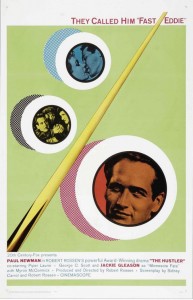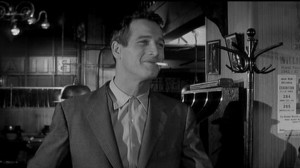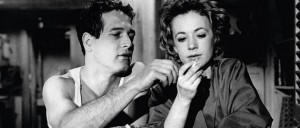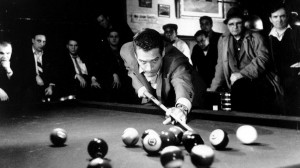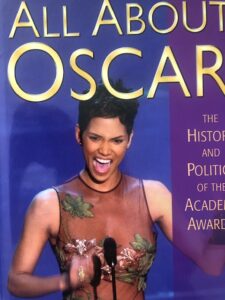Robert Rossen, the Oscar winning director for All the King’s Men in 1949, directed the noirish pool drama The Hustler, based on a novel by Walter Tevis, which he co-scripted with Sidney Carroll.
Grade: A (***** out of *****)
In one of his best roles, Paul Newman plays pool hustler-con artist Eddie “Fast” Felson, a jaded, disillusioned young man, an adventurer that’s one notch above being a bum. In his direction, Rossen emphasizes Felson’s sense of buried life, tired cynicism, a world-weary mental outlook that was decidedly downbeat and pessimistic.
Felson may be down but not quite out. A pool shark who hustles in billiard rooms cross-country, Felson takes on suckers whom he allows to win until the stakes get high enough, at which point he clamps down with brilliant shots, makes a bundle and disappears.
With his manager-crony Charlie Bins (Myron McCormick), Eddie arrives sin New York to challenge the champion pool player of the 50 states, Minnesota Fats (Jackie Gleason). The two men battle it out on what author Tevis describes as the “field of the cloth of green. Felson is the winner, until arrogance and over confidence and booze bring him down. He ends up beaten and financially drained.
At an all-night diner, Felson meets Sarah Packard (Piper Laurie), a crippled woman who’s a disillusioned, life-weary and alcoholic. One thing leads to another and Felson moves into her place, and drifts around town hustling in third-rate pool places.
Onen night, Felson picks the wrong man and the loser’s friends corner him and break his thumbs. Comforted by Sarah, he begins to see her in a new light, though is unwilling to commit to the kind of relationship she wants and needs.
After recovering, Felson gets involved with Bert Gordon (George C. Scott), a ruthless and greedy gambler who arranges top-notch matches for Felson for 70 percent of the cut. Felson, Bert, and Sarah then hit the road to Kentucky, where Felson challenges and defeats a millionaire billiard addict named Findlay (Murray Hamilton).
Meanwhile, Sarah deteriorates rapidly, and Bert, who aims at dominating Felson, undermines her, driving her into suicide. Sarah’s death constitutes a turning point in Felson’s moral awakening, sobering him up, while realizing the last and lost chance he had for a meaningful relationship. He returns to New York, beats Minnesota Fats in a disciplined and brilliantly executed match, and refuses to hand Bert his cut. In the end, Felson denounces his self-centeredness and the inhuman life he had led.
Cinematographer Gene Shufton does a masterful job in conveying in black-and-white imagery the film’s tone what Minnesota Fats describes at one point as “the dirty, antiseptic look of poolrooms, with dirty spots on the floor, stuffed-up toilets. With the assist of Willie Mosconi, then the country’s top-ranking pool players, the matches are magnificently and realistically staged.
Film critics at the time, such as Variety’s, complained that “The Hustler” was too sordid and downbeat a picture, but there was a consensus about Newman’s stupendous performance, which deservedly earned him his second Best Actor Oscar (See below). There was also agreement that Rossen and his production team capture visually the smoky poetry of pool rooms and the religious zeal and obsession of professional pool players.
Contemporary critics see the final pool-hall showdown between Minnesota Fats and Felson as a Western shootout, with an interior landscape, distinct code of honor, and dingy world much like the Old West, where rites of manhood have the force of destiny.
Oscar Nominations: 9
Picture, produced by Robert Rossen
Director: Robert Rossen
Screenplay (Adapted): Sidney Carroll and Robert Rossen
Actor: Paul Newman
Actress: Piper Laurie
Supporting Actor: Jackie Gleason
Supporting Actor: George C. Scott
Cinematography (b/w): Eugen Shuftan
Art Direction-Set Decoration (b/w): Harry Horner and Gene Callahan
Oscar Awards: 2
Cinematography
Art Direction
Oscar Context:
In 1961, the musical “West Side Story” swept most of the Oscars, including Picture, Director(s) and Supporting Actor.
The other three Best Picture nominees were the old-fashioned melodrama “Fanny”; the WWII adventure “The Guns of Navarone”; “and the courtroom drama “Judgment at Nuremberg,” which was the most nominated film of the year.
The winner of the Actor Oscar was Maximilian Schell for Judgment at Nuremberg, which also won Adapted Screenplay for Abby Man. Piper Laurie lost the Actress Oscar to Sophia Loren in the Italian movie, “Two Women.”
Sequel
In 1986, Scorsese directed a sequel, “The Color of Money,” for which Newman finally won the Best Actor Oscar at his seventh nomination. The sequei is inferior to the original in every way,
Reel/Real Impact
“The Hustler” and “The Color of Money” led to a national interest in billiard and pool tables.
Credits
Produced and directed by Robert Rossen.
Screenplay by Robert Rossen and Sidney Carroll.
Based on the novel by Walter Tevis.
Photography, Gene Shufton.
Art Direction, Harry Horner and Albert Brenner.
Set Decorations, Gene Callahan.
Film Editor, Deedee Allan.
Sound, James Shields.
Technical Advisor, Willie Mosconi.
Unit Manager, John Graham.
Costumes, Ruth Morley.
Makeup, Bob Jiras.
Hairstyles, Deneene.
Assistant Directors, Charles Maguire and Don Kranz.
In CinemaScope.
Filmed in New York City.
Running time: 133 minutes.
Cast
Paul Newman
Jackie Gleason
Piper Laurie
George C. Scott
Myron McCormick
Murray Hamilton
Michael Constantine
Stefan Gierasch
Jake LaMotta
Gordon B. Clarke
Carl York
Alexander Rose
Carolyn Coates
Vincent Gardenia
Gloria Curtis
Charles Diercep
Donald Crabtree
Brendan Fay
Cliff Fellow
